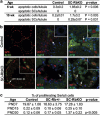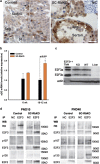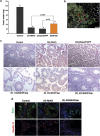Retinoblastoma protein (RB) interacts with E2F3 to control terminal differentiation of Sertoli cells
- PMID: 24901045
- PMCID: PMC4611710
- DOI: 10.1038/cddis.2014.232
Retinoblastoma protein (RB) interacts with E2F3 to control terminal differentiation of Sertoli cells
Abstract
The retinoblastoma protein (RB) is essential for normal cell cycle control. RB function depends, at least in part, on interactions with the E2F family of DNA-binding transcription factors (E2Fs). To study the role of RB in the adult testis, a Sertoli cell (SC)-specific Rb knockout mouse line (SC-RbKO) was generated using the Cre/loxP recombination system. SC-RbKO mice exhibited an age-dependent testicular atrophy, impaired fertility, severe SC dysfunction, and spermatogenic defects. Removal of Rb in SC induced aberrant SC cycling, dedifferentiation, and apoptosis. Here we show that E2F3 is the only E2F expressed in mouse SCs and that RB interacts with E2F3 during mouse testicular development. In the absence of RB, the other retinoblastoma family members p107 and p130 began interacting with E2F3 in the adult testes. In vivo silencing of E2F3 partially restored the SC maturation and survival as well as spermatogenesis in the SC-RbKO mice. These results point to RB as a key regulator of SC function in adult mice and that the RB/E2F3 pathway directs SC maturation, cell cycle quiescence, and RB protects SC from apoptosis.
Figures






Similar articles
-
Retinoblastoma protein represses E2F3 to maintain Sertoli cell quiescence in mouse testis.J Cell Sci. 2019 Jul 15;132(14):jcs229849. doi: 10.1242/jcs.229849. J Cell Sci. 2019. PMID: 31308245
-
Retinoblastoma-E2F Transcription Factor Interplay Is Essential for Testicular Development and Male Fertility.Front Endocrinol (Lausanne). 2022 May 19;13:903684. doi: 10.3389/fendo.2022.903684. eCollection 2022. Front Endocrinol (Lausanne). 2022. PMID: 35663332 Free PMC article. Review.
-
Neural precursor cells differentiating in the absence of Rb exhibit delayed terminal mitosis and deregulated E2F 1 and 3 activity.Dev Biol. 1999 Mar 15;207(2):257-70. doi: 10.1006/dbio.1998.9162. Dev Biol. 1999. PMID: 10068462
-
Rb-mediated neuronal differentiation through cell-cycle-independent regulation of E2f3a.PLoS Biol. 2007 Jul;5(7):e179. doi: 10.1371/journal.pbio.0050179. Epub 2007 Jul 3. PLoS Biol. 2007. PMID: 17608565 Free PMC article.
-
Activity of the retinoblastoma family proteins, pRB, p107, and p130, during cellular proliferation and differentiation.Crit Rev Biochem Mol Biol. 1996 Jun;31(3):237-71. doi: 10.3109/10409239609106585. Crit Rev Biochem Mol Biol. 1996. PMID: 8817077 Review.
Cited by
-
Expression and prognostic value of E2F3 transcription factor in non-small cell lung cancer.Oncol Lett. 2021 May;21(5):411. doi: 10.3892/ol.2021.12672. Epub 2021 Mar 22. Oncol Lett. 2021. PMID: 33841572 Free PMC article.
-
Transcriptional control of stem cell fate by E2Fs and pocket proteins.Front Genet. 2015 Apr 28;6:161. doi: 10.3389/fgene.2015.00161. eCollection 2015. Front Genet. 2015. PMID: 25972892 Free PMC article. Review.
-
E4 Transcription Factor 1 (E4F1) Regulates Sertoli Cell Proliferation and Fertility in Mice.Animals (Basel). 2020 Sep 18;10(9):1691. doi: 10.3390/ani10091691. Animals (Basel). 2020. PMID: 32962114 Free PMC article.
-
Identification of Transcription Factor-Related Gene Signature and Risk Score Model for Colon Adenocarcinoma.Front Genet. 2021 Sep 17;12:709133. doi: 10.3389/fgene.2021.709133. eCollection 2021. Front Genet. 2021. PMID: 34603375 Free PMC article.
-
E2F1 controls germ cell apoptosis during the first wave of spermatogenesis.Andrology. 2015 Sep;3(5):1000-14. doi: 10.1111/andr.12090. Andrology. 2015. PMID: 26311345 Free PMC article.
References
-
- 1Classon M, Harlow E. The retinoblastoma tumour suppressor in development and cancer. Nat Rev Cancer 2002; 2: 910–917. - PubMed
-
- 3Yan W, Kero J, Suominen J, Toppari J. Differential expression and regulation of the retinoblastoma family of proteins during testicular development and spermatogenesis: roles in the control of germ cell proliferation, differentiation and apoptosis. Oncogene 2001; 20: 1343–1356. - PubMed
-
- 4Yan W, West A, Toppari J, Lahdetie J. Stage-specific expression and phosphorylation of retinoblastoma protein (pRb) in the rat seminiferous epithelium. Mol Cell Endocrinol 1997; 132: 137–148. - PubMed
-
- 5Clarke AR, Maandag ER, van Roon M, van der Lugt NM, van der Valk M, Hooper ML et al. Requirement for a functional Rb-1 gene in murine development. Nature 1992; 359: 328–330. - PubMed
Publication types
MeSH terms
Substances
LinkOut - more resources
Full Text Sources
Other Literature Sources
Molecular Biology Databases

